springboot+shiro(java安全框架学习使用)
1、认识Shiro
Apache Shiro提供了一个强大而灵活的安全框架,可以为任何应用提供安全保障。用于认证和访问授权:满足对用户、角色、权限(操作权限)、资源(url),即用户分配角色,角色定义权限,访问授权时支持角色或者权限,并且支持多级的权限定义。
Shiro主要有三个核心组件:Subject、SecurityManager、Realms。
以下摘自:https://blog.youkuaiyun.com/qq_32786139/article/details/82658197
1、 Subject:即“当前操作用户”。但是,在Shiro中,Subject这一概念并不仅仅指人,也可以是第三方进程、后台帐户(Daemon Account)或其他类似事物。它仅仅意味着“当前跟软件交互的东西”。但考虑到大多数目的和用途,你可以把它认为是Shiro的“用户”概念。
Subject代表了当前用户的安全操作,SecurityManager则管理所有用户的安全操作。
2、 SecurityManager:它是Shiro框架的核心,典型的Facade模式,Shiro通过SecurityManager来管理内部组件实例,并通过它来提供安全管理的各种服务。
3、 Realm: Realm充当了Shiro与应用安全数据间的“桥梁”或者“连接器”。也就是说,当对用户执行认证(登录)和授权(访问控制)验证时,Shiro会从应用配置的Realm中查找用户及其权限信息。
从这个意义上讲,Realm实质上是一个安全相关的DAO:它封装了数据源的连接细节,并在需要时将相关数据提供给Shiro。当配置Shiro时,你必须至少指定一个Realm,用于认证和(或)授权。配置多个Realm是可以的,但是至少需要一个。
Shiro内置了可以连接大量安全数据源(又名目录)的Realm,如LDAP、关系数据库(JDBC)、类似INI的文本配置资源以及属性文件等。如果缺省的Realm不能满足需求,你还可以插入代表自定义数据源的自己的Realm实现。
2、开始demo项目搭建
2.1、创建项目
创建一个普通的springboot-web的项目,取名为springboot-shiro-demo
可以先不用选择依赖,然后把各个模块的包建好备用。

2.2、配置pom.xml文件
其中需要注意的mysql的依赖包,如果出错了,就把runtime
这个去掉,pom文件如下:
<?xml version="1.0" encoding="UTF-8"?>
<project xmlns="http://maven.apache.org/POM/4.0.0" xmlns:xsi="http://www.w3.org/2001/XMLSchema-instance"
xsi:schemaLocation="http://maven.apache.org/POM/4.0.0 http://maven.apache.org/xsd/maven-4.0.0.xsd">
<modelVersion>4.0.0</modelVersion>
<parent>
<groupId>org.springframework.boot</groupId>
<artifactId>spring-boot-starter-parent</artifactId>
<version>2.1.6.RELEASE</version>
<relativePath/> <!-- lookup parent from repository -->
</parent>
<groupId>com.springboot.shiro</groupId>
<artifactId>demo</artifactId>
<version>0.0.1-SNAPSHOT</version>
<name>demo</name>
<description>Demo project for Spring Boot</description>
<properties>
<project.build.sourceEncoding>UTF-8</project.build.sourceEncoding>
<project.reporting.outputEncoding>UTF-8</project.reporting.outputEncoding>
<java.version>1.8</java.version>
</properties>
<dependencies>
<dependency>
<groupId>org.springframework.boot</groupId>
<artifactId>spring-boot-starter-freemarker</artifactId>
</dependency>
<dependency>
<groupId>org.springframework.boot</groupId>
<artifactId>spring-boot-starter-jdbc</artifactId>
</dependency>
<dependency>
<groupId>org.springframework.boot</groupId>
<artifactId>spring-boot-starter-web</artifactId>
</dependency>
<dependency>
<groupId>org.mybatis.spring.boot</groupId>
<artifactId>mybatis-spring-boot-starter</artifactId>
<version>1.3.2</version>
</dependency>
<dependency>
<groupId>mysql</groupId>
<artifactId>mysql-connector-java</artifactId>
</dependency>
<dependency>
<groupId>org.springframework.boot</groupId>
<artifactId>spring-boot-starter-test</artifactId>
<scope>test</scope>
</dependency>
<!-- 数据库连接池 -->
<dependency>
<groupId>com.alibaba</groupId>
<artifactId>druid</artifactId>
<version>1.1.10</version>
</dependency>
<!-- Shiro -->
<dependency>
<groupId>org.apache.shiro</groupId>
<artifactId>shiro-spring</artifactId>
<version>1.3.2</version>
</dependency>
<!-- log4j -->
<dependency>
<groupId>log4j</groupId>
<artifactId>log4j</artifactId>
<version>1.2.17</version>
</dependency>
<dependency>
<groupId>org.springframework.boot</groupId>
<artifactId>spring-boot-devtools</artifactId>
<optional>true</optional>
</dependency>
</dependencies>
<build>
<plugins>
<plugin>
<groupId>org.springframework.boot</groupId>
<artifactId>spring-boot-maven-plugin</artifactId>
</plugin>
</plugins>
</build>
</project>
2.3、配置application.yml文件
主要是设置数据库连接池和mvc的静态资源路径等,注意application.yml文件的编码格式和中文中文注释,实在不行就不要中文注释了。还有一定要注意这个文件的缩进,不能使用空格代替TAB,并且有严格的缩进要求(要对齐)。
application.yml文件如下:
spring:
datasource:
url: jdbc:mysql://10.10.38.54:3306/tao_dev?useUnicode=true&characterEncoding=UTF-8&useJDBCCompliantTimezoneShift=true&useLegacyDatetimeCode=false&serverTimezone=UTC
username: root
password: 123456
driver-class-name: com.mysql.cj.jdbc.Driver
type: com.alibaba.druid.pool.DruidDataSource
initialSize: 5
minInle: 5
maxActive: 20
maxWait: 60000
timeBetweenEvictionRunsMillis: 60000
minEvictableIdleTimeMillis: 300000
validationQuery: SELECT 1 FROM DUAL
testOnBorrow: false
testOnReturn: false
testWhileIdle: true
poolPreparedStatements: false
filters: stat,wall,log4j
freemarker:
suffix: .html
charset: utf-8
mvc:
static-path-pattern: /static/**
mybatis:
mapper-locations: classpath:mappers/*.xml
type-aliases-package: com.springboot.shiro.demo.pojo
2.4、建表
在数据库中建五张表:shiro_user(用户表)、shiro_role(角色表)、shiro_permission(权限表)、shiro_user_role(用户角色关联表)、shiro_role_permission(角色资源关联表)。表结构和具体关联信息如下:

建完表之后给各个表填入基础数据:
INSERT INTO `shiro_user` VALUES ('1', 'hutao', 'f7c3aea7e18076502c9e29fc4d4d16f9');
INSERT INTO `shiro_user` VALUES ('2', 'vip', '01ffb6fc48048d105ba5061f8df5a35e');
其他的表手动填一下,就不用运行sql语句了:
shiro_role表:

shiro_user_role表:
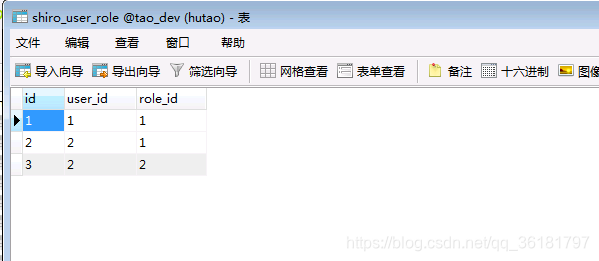
shiro_permission表:

shiro_role_permission表:
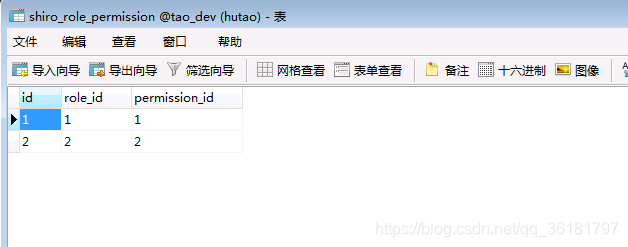
2.5、各个类
整个项目的文件目录如下:

2.5.1、三个实体类
package com.springboot.shiro.demo.pojo;
import java.io.Serializable;
import java.util.HashSet;
import java.util.Set;
/**
* @Name:
* @Description: 用户实体类
* @Author:hutao2@myhexin.com
* @Date:2019/7/19 10:17
*/
public class UserBean implements Serializable {
private String id;
private String name;
private String password;
private Set<RoleBean> roles = new HashSet<>();
public Set<RoleBean> getRoles() {
return roles;
}
public void setRoles(Set<RoleBean> roles) {
this.roles = roles;
}
public String getPassword() {
return password;
}
public void setPassword(String password) {
this.password = password;
}
public String getName() {
return name;
}
public void setName(String name) {
this.name = name;
}
public String getId() {
return id;
}
public void setId(String id) {
this.id = id;
}
}
package com.springboot.shiro.demo.pojo;
import java.io.Serializable;
import java.util.HashSet;
import java.util.Set;
/**
* @Name: 角色实体类
* @Description:
* @Author:hutao2@myhexin.com
* @Date:2019/7/19 10:17
*/
public class RoleBean implements Serializable {
private String id;
private String name;
private Set<PermissionBean> permissions = new HashSet<>();
public Set<PermissionBean> getPermissions() {
return permissions;
}
public void setPermissions(Set<PermissionBean> permissions) {
this.permissions = permissions;
}
public String getId() {
return id;
}
public void setId(String id) {
this.id = id;
}
public String getName() {
return name;
}
public void setName(String name) {
this.name = name;
}
}
package com.springboot.shiro.demo.pojo;
import java.io.Serializable;
/**
* @Name: 权限实体类
* @Description:
* @Author:hutao2@myhexin.com
* @Date:2019/7/19 10:17
*/
public class PermissionBean implements Serializable {
private String id;
private String name;
private String url;
public String getId() {
return id;
}
public void setId(String id) {
this.id = id;
}
public String getName() {
return name;
}
public void setName(String name) {
this.name = name;
}
public String getUrl() {
return url;
}
public void setUrl(String url) {
this.url = url;
}
}
2.5.2、mapper和xml文件
package com.springboot.shiro.demo.mapper;
import com.springboot.shiro.demo.pojo.UserBean;
/**
* @Name:
* @Description:
* @Author:hutao2@myhexin.com
* @Date:2019/7/19 10:17
*/
public interface UserMapper {
//查询用户信息
UserBean findByName(String name);
//查询用户信息、角色、权限
UserBean findById(String id);
}
<?xml version="1.0" encoding="UTF-8"?>
<!DOCTYPE mapper PUBLIC "-//mybatis.org//DTD Mapper 3.0//EN" "http://mybatis.org/dtd/mybatis-3-mapper.dtd">
<mapper namespace="com.springboot.shiro.demo.mapper.UserMapper">
<resultMap id="userMap" type="UserBean">
<id property="id" column="id"/>
<result property="name" column="name"/>
<result property="password" column="password"/>
<collection property="roles" ofType="RoleBean">
<id property="id" column="roleId"/>
<result property="name" column="roleName"/>
<collection property="permissions" ofType="PermissionBean">
<id property="id" column="permissionId"/>
<result property="name" column="permissionName"/>
<result property="url" column="permissionUrl"/>
</collection>
</collection>
</resultMap>
<select id="findByName" parameterType="String" resultType="UserBean">
SELECT id, name, password
FROM shiro_user
WHERE NAME = #{name}
</select>
<select id="findById" parameterType="String" resultMap="userMap">
SELECT shiro_user.id, shiro_user.name, shiro_user.password,
shiro_role.id as roleId, shiro_role.name as roleName,
shiro_permission.id as permissionId,
shiro_permission.name as permissionName,
shiro_permission.url as permissionUrl
FROM shiro_user, shiro_user_role, shiro_role, shiro_role_permission, shiro_permission
WHERE shiro_user.id = #{id}
AND shiro_user.id = shiro_user_role.user_id
AND shiro_user_role.role_id = shiro_role.id
AND shiro_role.id = shiro_role_permission.role_id
AND shiro_role_permission.permission_id = shiro_permission.id
</select>
</mapper>
注意:xml文件中报错不影响运行。
2.5.3、两个config
package com.springboot.shiro.demo.config;
import com.alibaba.druid.pool.DruidDataSource;
import com.alibaba.druid.support.http.StatViewServlet;
import com.alibaba.druid.support.http.WebStatFilter;
import org.springframework.boot.context.properties.ConfigurationProperties;
import org.springframework.boot.web.servlet.FilterRegistrationBean;
import org.springframework.boot.web.servlet.ServletRegistrationBean;
import org.springframework.context.annotation.Bean;
import org.springframework.context.annotation.Configuration;
import javax.sql.DataSource;
import java.util.HashMap;
import java.util.Map;
/**
* @Name:
* @Description:
* @Author:hutao2@myhexin.com
* @Date:2019/7/19 10:15
*/
@Configuration
public class DruidConfig {
@ConfigurationProperties(prefix="spring.datasource")
@Bean(destroyMethod = "close", initMethod = "init")
public DataSource druid(){
return new DruidDataSource();
}
/**
* 配置监控服务器
*/
@Bean
public ServletRegistrationBean statViewServlet(){
ServletRegistrationBean bean = new ServletRegistrationBean(new StatViewServlet(),"/druid/*");
Map<String, String> initParams = new HashMap<>();
//druid后台管理员
initParams.put("loginUsername","admin");
initParams.put("loginPassword","123456");
//是否能够重置数据
initParams.put("resetEnable","false");
bean.setInitParameters(initParams);
return bean;
}
/**
* 配置web监控的过滤器
*/
@Bean
public FilterRegistrationBean webStatFilter(){
FilterRegistrationBean bean = new FilterRegistrationBean(new WebStatFilter());
//添加过滤规则
bean.addUrlPatterns("/*");
Map<String,String> initParams = new HashMap<>();
//忽略过滤格式
initParams.put("exclusions","*.js,*.css,*.icon,*.png,*.jpg,/druid/*");
bean.setInitParameters(initParams);
return bean;
}
}
package com.springboot.shiro.demo.config;
import com.springboot.shiro.demo.realm.UserRealm;
import org.apache.shiro.authc.credential.HashedCredentialsMatcher;
import org.apache.shiro.spring.web.ShiroFilterFactoryBean;
import org.apache.shiro.web.mgt.DefaultWebSecurityManager;
import org.springframework.beans.factory.annotation.Qualifier;
import org.springframework.context.annotation.Bean;
import org.springframework.context.annotation.Configuration;
import java.util.LinkedHashMap;
import java.util.Map;
/**
* @Name:
* @Description: shiro配置类
* @Author:hutao2@myhexin.com
* @Date:2019/7/19 10:16
*/
@Configuration
public class ShiroConfig {
@Bean("hashedCredentialsMatcher")
public HashedCredentialsMatcher hashedCredentialsMatcher() {
HashedCredentialsMatcher credentialsMatcher =
new HashedCredentialsMatcher();
//指定加密方式为MD5
credentialsMatcher.setHashAlgorithmName("MD5");
//加密次数
credentialsMatcher.setHashIterations(1024);
credentialsMatcher.setStoredCredentialsHexEncoded(true);
return credentialsMatcher;
}
@Bean("userRealm")
public UserRealm userRealm(@Qualifier("hashedCredentialsMatcher")
HashedCredentialsMatcher matcher) {
UserRealm userRealm = new UserRealm();
userRealm.setCredentialsMatcher(matcher);
return userRealm;
}
@Bean
public ShiroFilterFactoryBean shirFilter(@Qualifier("securityManager")
DefaultWebSecurityManager securityManager) {
ShiroFilterFactoryBean bean = new ShiroFilterFactoryBean();
// 设置 SecurityManager
bean.setSecurityManager(securityManager);
// 设置登录成功跳转Url
bean.setSuccessUrl("/main");
// 设置登录跳转Url
bean.setLoginUrl("/toLogin");
// 设置未授权提示Url
bean.setUnauthorizedUrl("/error/unAuth");
/**
* anon:匿名用户可访问
* authc:认证用户可访问
* user:使用rememberMe可访问
* perms:对应权限可访问
* role:对应角色权限可访问
**/
Map<String, String> filterMap = new LinkedHashMap<>();
filterMap.put("/login","anon");
filterMap.put("/user/index","authc");
filterMap.put("/vip/index","roles[vip]");
filterMap.put("/druid/**", "anon");
filterMap.put("/static/**","anon");
filterMap.put("/**","authc");
filterMap.put("/logout", "logout");
bean.setFilterChainDefinitionMap(filterMap);
return bean;
}
/**
* 注入 securityManager
*/
@Bean(name="securityManager")
public DefaultWebSecurityManager getDefaultWebSecurityManager(
HashedCredentialsMatcher hashedCredentialsMatcher) {
DefaultWebSecurityManager securityManager =
new DefaultWebSecurityManager();
// 关联realm.
securityManager.setRealm(userRealm(hashedCredentialsMatcher));
return securityManager;
}
}
2.5.4、realm
package com.springboot.shiro.demo.realm;
import com.springboot.shiro.demo.pojo.PermissionBean;
import com.springboot.shiro.demo.pojo.RoleBean;
import com.springboot.shiro.demo.pojo.UserBean;
import com.springboot.shiro.demo.service.UserService;
import org.apache.shiro.SecurityUtils;
import org.apache.shiro.authc.*;
import org.apache.shiro.authc.credential.HashedCredentialsMatcher;
import org.apache.shiro.authz.AuthorizationInfo;
import org.apache.shiro.authz.SimpleAuthorizationInfo;
import org.apache.shiro.crypto.hash.SimpleHash;
import org.apache.shiro.realm.AuthorizingRealm;
import org.apache.shiro.subject.PrincipalCollection;
import org.apache.shiro.subject.Subject;
import org.apache.shiro.util.ByteSource;
import org.springframework.beans.factory.annotation.Autowired;
import java.util.Collection;
import java.util.HashSet;
import java.util.Set;
/**
* @Name:
* @Description: 自定义Realm,实现授权与认证
* @Author:hutao2@myhexin.com
* @Date:2019/7/19 10:18
*/
public class UserRealm extends AuthorizingRealm {
@Autowired
private UserService userService;
/**
* 用户授权
**/
@Override
protected AuthorizationInfo doGetAuthorizationInfo(
PrincipalCollection principalCollection) {
System.out.println("===执行授权===");
Subject subject = SecurityUtils.getSubject();
UserBean user = (UserBean)subject.getPrincipal();
if(user != null){
SimpleAuthorizationInfo info = new SimpleAuthorizationInfo();
// 角色与权限字符串集合
Collection<String> rolesCollection = new HashSet<>();
Collection<String> premissionCollection = new HashSet<>();
// 读取并赋值用户角色与权限
Set<RoleBean> roles = user.getRoles();
for(RoleBean role : roles){
rolesCollection.add(role.getName());
Set<PermissionBean> permissions = role.getPermissions();
for (PermissionBean permission : permissions){
premissionCollection.add(permission.getUrl());
}
info.addStringPermissions(premissionCollection);
}
info.addRoles(rolesCollection);
return info;
}
return null;
}
/**
* 用户认证
**/
@Override
protected AuthenticationInfo doGetAuthenticationInfo(
AuthenticationToken authenticationToken) throws AuthenticationException {
System.out.println("===执行认证===");
UsernamePasswordToken token = (UsernamePasswordToken)authenticationToken;
UserBean bean = userService.findByName(token.getUsername());
if(bean == null){
throw new UnknownAccountException();
}
ByteSource credentialsSalt = ByteSource.Util.bytes(bean.getName());
return new SimpleAuthenticationInfo(bean, bean.getPassword(),
credentialsSalt, getName());
}
// 模拟Shiro用户加密,假设用户密码为123456
public static void main(String[] args){
// 用户名
String username = "hutao";
// 用户密码
String password = "123456";
// 加密方式
String hashAlgorithName = "MD5";
// 加密次数
int hashIterations = 1024;
ByteSource credentialsSalt = ByteSource.Util.bytes(username);
Object obj = new SimpleHash(hashAlgorithName, password,
credentialsSalt, hashIterations);
System.out.println(obj);
}
}
2.5.5、service层
接口类:
package com.springboot.shiro.demo.service;
import com.springboot.shiro.demo.pojo.UserBean;
/**
* @Name:
* @Description: UserService抽象接口
* @Author:hutao2@myhexin.com
* @Date:2019/7/19 10:18
*/
public interface UserService {
UserBean findByName(String name);
}
接口实现类:
package com.springboot.shiro.demo.service.impl;
import com.springboot.shiro.demo.mapper.UserMapper;
import com.springboot.shiro.demo.pojo.UserBean;
import com.springboot.shiro.demo.service.UserService;
import org.springframework.beans.factory.annotation.Autowired;
import org.springframework.stereotype.Service;
/**
* @Name:
* @Description: Userservice实现类
* @Author:hutao2@myhexin.com
* @Date:2019/7/19 10:19
*/
@Service
public class UserServiceImpl implements UserService {
@Autowired
private UserMapper userMapper;
@Override
public UserBean findByName(String name) {
// 查询用户是否存在
UserBean bean = userMapper.findByName(name);
if (bean != null) {
// 查询用户信息、角色、权限
bean = userMapper.findById(bean.getId());
}
return bean;
}
}
2.5.6、controller层
MainController:
package com.springboot.shiro.demo.controller;
import org.apache.shiro.SecurityUtils;
import org.apache.shiro.authc.IncorrectCredentialsException;
import org.apache.shiro.authc.UnknownAccountException;
import org.apache.shiro.authc.UsernamePasswordToken;
import org.apache.shiro.subject.Subject;
import org.springframework.stereotype.Controller;
import org.springframework.web.bind.annotation.RequestMapping;
import javax.servlet.http.HttpServletRequest;
import javax.servlet.http.HttpServletResponse;
/**
* @Name:
* @Description: 用户登录、登出、错误页面跳转控制器
* @Author:hutao2@myhexin.com
* @Date:2019/7/19 10:16
*/
@Controller
public class MainController {
@RequestMapping("/main")
public String index(HttpServletRequest request, HttpServletResponse response){
response.setHeader("root", request.getContextPath());
return "index";
}
@RequestMapping("/toLogin")
public String toLogin(HttpServletRequest request, HttpServletResponse response){
response.setHeader("root", request.getContextPath());
return "login";
}
@RequestMapping("/login")
public String login(HttpServletRequest request, HttpServletResponse response){
response.setHeader("root", request.getContextPath());
String userName = request.getParameter("username");
String password = request.getParameter("password");
// 1.获取Subject
Subject subject = SecurityUtils.getSubject();
// 2.封装用户数据
UsernamePasswordToken token = new UsernamePasswordToken(userName, password);
// 3.执行登录方法
try{
subject.login(token);
return "redirect:/main";
} catch (UnknownAccountException e){
e.printStackTrace();
request.setAttribute("msg","用户名不存在!");
} catch (IncorrectCredentialsException e){
request.setAttribute("msg","密码错误!");
}
return "login";
}
@RequestMapping("/logout")
public String logout(){
Subject subject = SecurityUtils.getSubject();
if (subject != null) {
subject.logout();
}
return "redirect:/main";
}
@RequestMapping("/error/unAuth")
public String unAuth(){
return "/error/unAuth";
}
}
UserController:
package com.springboot.shiro.demo.controller;
import com.springboot.shiro.demo.pojo.UserBean;
import org.apache.shiro.SecurityUtils;
import org.springframework.stereotype.Controller;
import org.springframework.web.bind.annotation.RequestMapping;
import javax.servlet.http.HttpServletRequest;
/**
* @Name:
* @Description: 用户页面跳转
* @Author:hutao2@myhexin.com
* @Date:2019/7/19 10:16
*/
@Controller
public class UserController {
/**
* 个人中心,需要认证可访问
*/
@RequestMapping("/user/index")
public String add(HttpServletRequest request){
UserBean bean = (UserBean) SecurityUtils.getSubject().getPrincipal();
request.setAttribute("userName", bean.getName());
return "/user/index";
}
/**
* 会员中心,需认证且角色为vip可访问
*/
@RequestMapping("/vip/index")
public String update(){
return "/vip/index";
}
}
2.5.7、项目页面
1、login.html:
<!DOCTYPE html>
<html lang="en">
<head>
<meta charset="UTF-8">
<title>登录</title>
</head>
<body>
<h1>用户登录</h1>
<hr>
<form id="from" action="${root!}/login" method="post">
<table>
<tr>
<td>用户名</td>
<td>
<input type="text" name="username" placeholder="请输入账户名"/>
</td>
</tr>
<tr>
<td>密码</td>
<td>
<input type="password" name="password" placeholder="请输入密码"/>
</td>
</tr>
<tr>
<td colspan="2">
<font color="red">${msg!}</font>
</td>
</tr>
<tr>
<td colspan="2">
<input type="submit" value="登录"/>
<input type="reset" value="重置"/>
</td>
</tr>
</table>
</form>
</body>
</html>
index.html 首页:
<!DOCTYPE html>
<html>
<head>
<title>首页</title>
</head>
<body>
<h1>首页</h1>
<hr>
<ul>
<li><a href="user/index">个人中心</a></li>
<li><a href="vip/index">会员中心</a></li>
<li><a href="logout">退出登录</a></li>
</ul>
</body>
</html>
/user/index.html 用户中心:
<!DOCTYPE html>
<html>
<head>
<title>用户中心</title>
</head>
<body>
<h1>用户中心</h1>
<hr>
<h1>欢迎${userName!},这里是用户中心</h1>
</body>
</html>
/vip/index.html 会员中心:
<!DOCTYPE html>
<html>
<head>
<title>会员中心</title>
</head>
<body>
<h1>会员中心</h1>
<hr>
<h1>欢迎来到<font color="red">会员中心</font></h1>
</body>
</html>
/error/unAuth.html 未授权展示页面:
<!DOCTYPE html>
<html>
<head>
<title>未授权提示</title>
</head>
<body>
<h1>您还不是<font color="red">会员</font>,没有权限访问这个页面!</h1>
</body>
</html>
3、运行结果
普通用户身份:
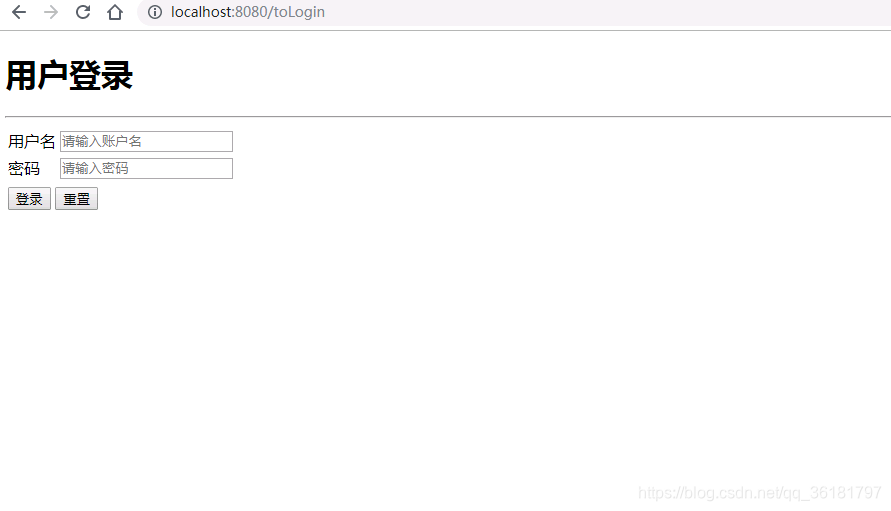 输入账号密码后,进入页面:
输入账号密码后,进入页面:
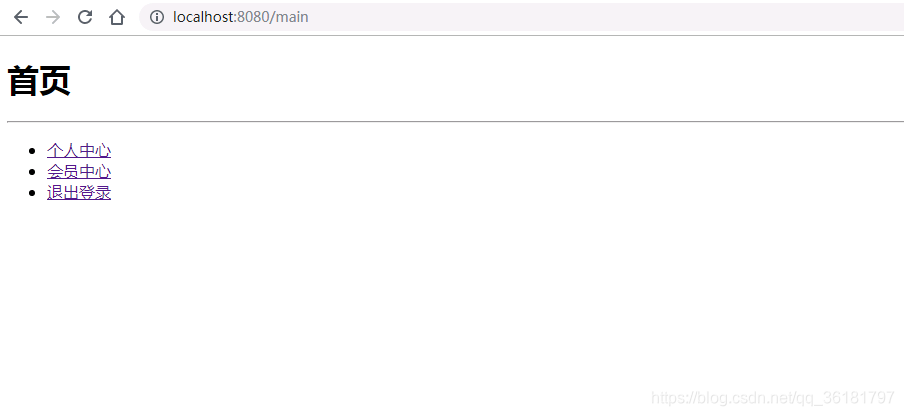
点击个人中心:

若是点击会员中心:
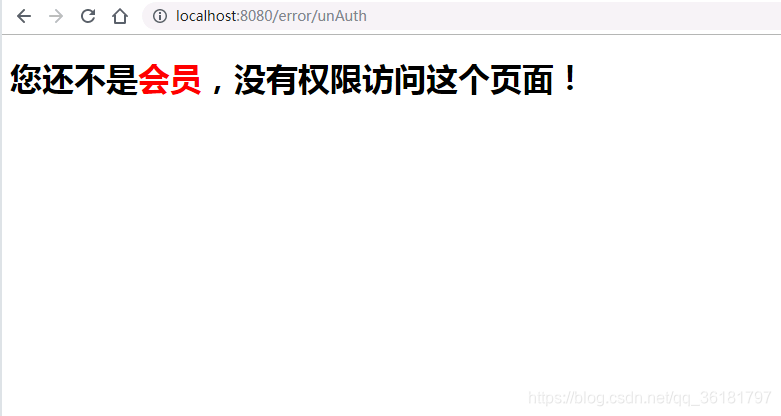
会员身份登录:
因为会员拥有最高权限,所以可以访问所有页面:
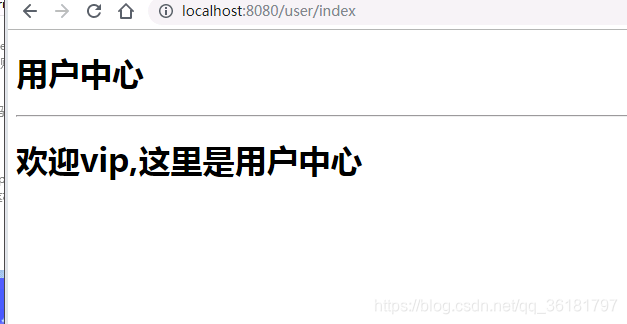

4、说明
本次demo学习全是借鉴 https://blog.youkuaiyun.com/qq_34802416/article/details/84959457
这篇文章来进行的,通过自己亲手搭建了一遍这个简单的demo,更加容易的学习到了springboot+shiro的整合以及shiro的工作原理。
























 429
429

 被折叠的 条评论
为什么被折叠?
被折叠的 条评论
为什么被折叠?








